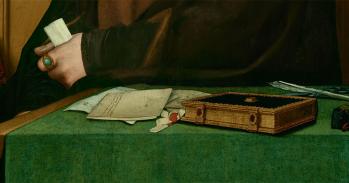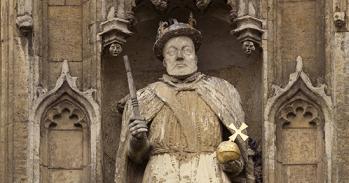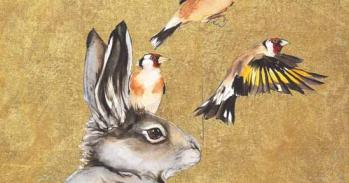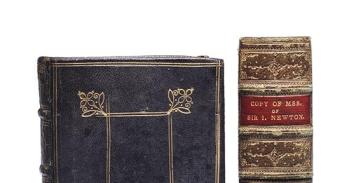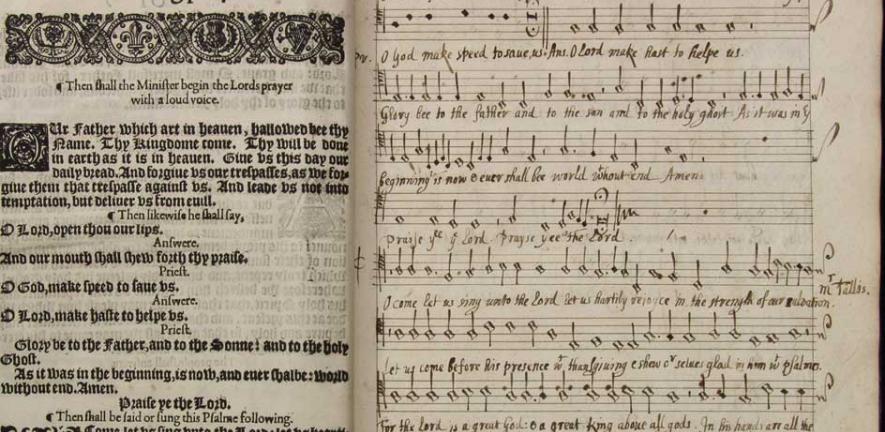
This year's Open Cambridge programme offers a rare chance to visit the historic Old Library at Queens' College, where the collection represents a window on to the intellectual upheaval of the 17th century.
This year's Open Cambridge programme offers a rare chance to visit the historic Old Library at Queens' College, where the collection represents a window on to the intellectual upheaval of the 17th century.
With the explosion in print culture in the 17th century, libraries became a tool for the advancement of new kinds of knowledge.
Queens College Librarian, Tim Eggington
In 1652 John Smith, a philosopher and "founder" of the so-called Cambridge Platonists, left his collection of 680 books to Queens’ College. Eight years earlier he had been elected to the Queens’ fellowship and appointed lecturer in Hebrew. His generous donation is itemised in a donors’ book, initiated in 1631, that records gifts to the library from the period 1562 to the late 18th century. Noted alphabetically by author and title, Smith’s gift reveals an eclecticism rare today, comprising humanist learning (Plato, Plotinus and Plutarch), the newer philosophies (Descartes, Galileo, Harvey, Kepler), as well as medicine, geography, travel and much else.
The donors’ book is one of several historic books on display in a small exhibition at Queens’ College Old Library which will be open to visitors on a drop-in basis from 10am to 3pm on Saturday, 8 September as part of Open Cambridge 2012. The display features books acquired by Queens’ in the 17th century, a period when libraries were undergoing a transition as the result of the spread of new ideas and the emergence of new technologies.
“The diverse range of books on display is testament to an exhilarating and tumultuous episode in western history. Seventeenth century religious and political upheavals together with the scientific and intellectual advances that define that age drove a colossal expansion in book production, both in terms of titles and subjects covered,” explained librarian Tim Eggington.
“Up to this point libraries were seen as store houses of timeless scholastic and humanist knowledge. With the explosion in print culture in the 17th century, they became a tool for the advancement of new kinds of knowledge. We see evidence of this transition in Queens’ College Old Library, where alongside the imperative to collect the new philosophies of Descartes and Galileo, changing attitudes to historical discovery led to an unprecedented interest in old books and the past. This meant that from the early 17th century medieval manuscripts, disposed of as obsolete a century early, were being collected once again.”
Queens’ College Old Library, reached from the Old Court through the archway beneath its colourful sundial and clock tower, is known for its collection of early printed books dating from the 16th century. Interestingly, the development of printing in the later 15th and 16th centuries prompted the library to make space for new volumes by discarding its entire collection of manuscripts, some of which can now be found in the libraries of other Cambridge Colleges.
A key distinction of Queens’ College Old Library is that, unlike many libraries of early printed books, its collection has escaped rebinding and other forms of ‘restoration’ and thus offers a precious window on to our intellectual past. Reader annotations and other signs of use and ownership – including tell-tale holes showing that books were once chained to reading desks – all serve to show how and why these books were read and used, as well as the value that was placed upon them. Few of the volumes on the shelves have any identification on their spines because up to the late 17th century books were stored with their fore edge on display rather than their spine as they are today.
The library is also notable for its numerous 16th-century bindings with intricate decorations made by impressing heated metal tools into the leather. A prime English example is evident in a number of bindings displaying mythical beasts combined with the characteristic double G of Garrett Godfrey, a binder originally from the Netherlands who worked in Cambridge in the early 16th century. “Garrett Godfrey is one of the finest and best known of Cambridge book binders. Apart from their workmanship and sheer visual appeal, the distinctiveness of his roll-produced designs helps us to form a picture of when a particular book was actually in Cambridge and the value that was placed on it,” said Eggington.
The tall oak bookcases which hold the books today date from the 15th century making them early examples of this type of storage system. The base of the cases date from 1448 with a top level (replete with elaborate cornicing and classical motifs) added in 1612. A middle layer was inserted in 1637. The books shelved at the top are now some 12 feet from the floor and can be reached only with a ladder.
Like many of Cambridge’s historic libraries, the Old Library at Queens’ is on the first floor to safeguard it from the ravages of flood. Damp remains one of the greatest enemies of rare books and ancient buildings are notoriously damp and draughty. However, the remarkably good condition of the collection is evidence that the library has proved to be a remarkably good environment. It takes the form of a long chamber, with an oak floor and windows on either side to aid reading in an age before electricity, situated between the President’s Lodge and the Chapel, with doorways at either end. The stained glass windows came from the Carmelite Friary that stood the opposite side of Old Court.
A massive wooden and iron trunk that once held the College silver has found a resting place in one of the bays. It dates from 1448 – and similar trunks are found in other Cambridge Colleges. Portraits of Erasmus remind visitors that the Humanist scholar is likely to have studied in the Library during his time at Queens’ in the early 15th century. Several books once owned by Erasmus’s colleagues can be found in its collection, including a copy of Erasmus’s Greek New Testament translation which was previously the property of his friend, the Polish Protestant reformer John Lasky (1499- 1560).
Also on display as part of the current exhibition is a 1636 book of common prayer interleaved with the tenor part of church music that would have been performed in the College Chapel in the years before the Civil War. Some of the music by famous Reformation composers, some by lesser known Cambridge musicians, this volume is hugely significant as a key to understanding the college’s musical and religious life during a time of religious change and artistic flowering.
The survival of this volume resonates with a key theme of the current exhibition. “Whereas in former times music was deemed ephemeral and unworthy of curation by libraries, the active preservation by Queens’ College of this volume in the later 17th century reflects the growing imperative to map England’s proud musical past,” said Eggington.
“This choir book and innumerable other volumes of unique significance serve to emphasise the importance of the library as a record of our intellectual, social and political heritage. We hope that exhibitions and events like Open Cambridge will raise awareness of the collection’s potential for teaching and research.”
Other libraries opening their doors to the public during Open Cambridge are: Cambridge Central Library, the Bodley Library at Christ's College, Cambridge University Library, St John's College Old Library, the Old Library Trinity Hall,the Parker Library at Corpus Christi College, and the English Faculty Library.
This work is licensed under a Creative Commons Licence. If you use this content on your site please link back to this page.


